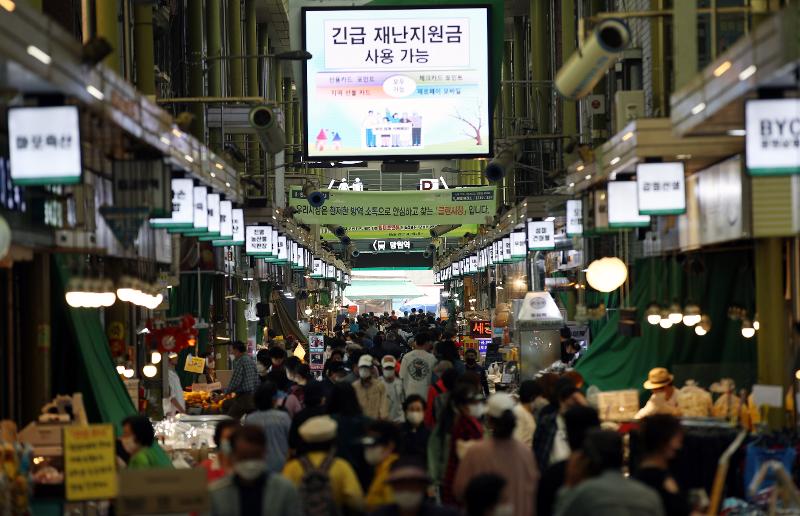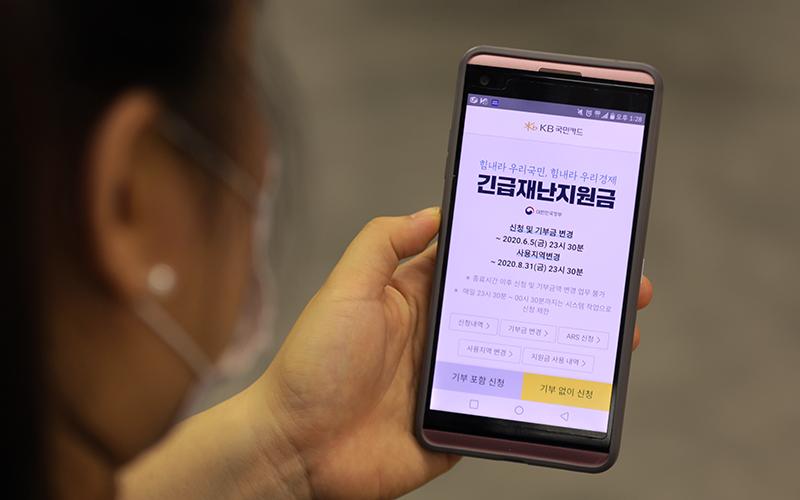
The government's emergency relief payments for all citizens has gradually raised domestic consumption. The photo above is of bustling Mangwon Market in Seoul on May 26. (Yonhap News)
By Lee Kyoung Mi and Lee Jihae
"I thought I had to close my business because of that novel coronavirus disease (COVID-19). But I'm now more at ease thanks to the emergency relief payments."
Lee Jin-won, a seller of dried fish at Daegu's Seomun Market for 15 years, is smiling again for the first time in a while. Seeing visitors in the market was hard over the past few months due to COVID-19, but things have grown more vibrant lately.
Kim Hee-ja, who runs a rice cake store at Seoul's Tongin Market, said, "I think consumers these days are buying or eating things they'd wanted to," adding, "The number of customers has increased."
The government sought to respond to the COVID-19 crisis, stabilize the people's daily lives and recover the contracted economy by giving the emergency relief payments to all citizens regardless of income or property.
The Ministry of the Interior and Safety said 99.5% or 21.6 million of 21.71 million eligible households had received the money as of June 8. Worth a combined KRW 13.59 trillion, the funds were doled out as cash, credits to debit and credit cards, and gift certificates. Almost everyone eligible got the aid about a month after the government began receiving applications in early May.
The stimulus measure showed immediate effects. Consumer sentiment, which had tanked due to COVID-19, began to rise again and people started to return to traditional markets and shopping districts nationwide.
Vendors posted in front of their stores signs reading "We accept emergency relief payments" and welcomed use of the fund. Consumers started shopping with more comfort.
According to a study on the small business market conducted by the Small Enterprise and Market Service from May 18-22, the consumer sentiment index significantly rose from April. The effects were the biggest in the restaurant, clothing and shoes, and livestock industries.
The ministry on June 10 announced the results of a study on the use of the emergency fund as credits to debit and credit cards. The study showed that sales at neighborhood and traditional markets rose after the stimulus measure was implemented, with most of the spending going toward dining out (24.8%), discount supermarket chains and groceries (24.2%), and hospitals and pharmacies (10.4%). About half of the funds went for eating.
Korea also distributed its stimulus funds faster than other countries that gave out similar aid, such as the U.S., Japan and Singapore.
The U.S. government began sending stimulus checks based on income about a month earlier than Korea. Washington announced plans to distribute all the funds by April, but about 80 million people had not received the money by late that month.
Japan also gave a payout of JPY 100,000 to each citizen around the same time as Korea did. According to the Japanese Ministry of Internal Affairs and Communications, 35.9% or 21.01 million of an estimated 58.53 million eligible households had received the funds as of June 12.

A credit app allows those eligible to apply for the government's emergency relief payment. (Choi Tae-soon)
Koreans, however, received the funds quickly due to their nation's fast broadband and wireless network infrastructure, the ubiquity of smartphones, and the government's efforts toward achieving outstanding IT technology and efficient administration.
The application process was simplified so that the time needed to apply for and receive the funds was under a minute after logging into a card company's app or the online website. The credit can be used as quickly as the next day after application.
"The bolstering of consumption – one of the aims of the emergency relief payments – is being realized. This is attributed to the people having actively spent the funds to help the difficulty-ridden national economy."
km137426@korea.kr